Calculus > STUDY GUIDE > C157 and C128 Combined Test With 70 Questions And Answers With Rationales (All)
C157 and C128 Combined Test With 70 Questions And Answers With Rationales
Document Content and Description Below
C157 and C128 Combined Test With Questions Answers With Rationales Analyze each question and choose the best response. Record your rationale for each choice. 1. Quality improvement assumes that: ... a. Most problems with service delivery result from process difficulties, not individuals. b. Frequent inspection is necessary to improve quality. c. Employees generally try to avoid work. d. Top management leads all quality improvement activities. 2. The term “quality” as used in quality improvement usually refers to: a. Characteristics of a product or service that bear on its ability to satisfy stated or implied needs. b. A product or service free of deficiencies. c. Having a high degree of excellence. d. All of the above. 3. The major difference between traditional “quality assurance” activities (e.g., keeping track of the total number of different procedures conducted in your practice, rates of adverse outcomes) and “quality improvement” activities is that quality improvement also focuses on: a. People and competency. b. Analysis of data. c. Performance measures. d. Systems and processes. 4. Effective quality improvement does not require: a. Leadership and commitment from management with long-term vision. b. An increased emphasis on inspection of individuals’ work. c. Increased investment on employee education and training. d. Scientific redesign of processes/services 5. A leadership style that is said to motivate employees, and that optimizes the introduction of change is: a. Autocratic – A clear top-down approach where a single individual has complete power of decision-making and little discussion is had for external input. b. Consultative – A style where leaders engage subordinates/peers in the decision-making and problem-solving process, but ultimately make the final decisions for the team. c. Participatory – An approach where leaders interact with other participants as peers, engaging them in the decision-making process and playing an equal role in the process as others and jointly carrying out the problem solving activities. d. Democratic – An open style of running a team where leaders facilitate discussion among all members, encourage ideas to be shared, and consider everyone’s input in order to make final decisions for the team. 6. Which representatives of a CV practice should be included on a quality improvement team to implement a new practice: a. Cardiologists only. b. Cardiologists and nurse practitioners. c. Cardiologists, nurse practitioners, quality improvement staff, and practice administrator. d. All staff directly affected by the quality improvement practice to be implemented. 7. When is it appropriate to collect and use data? a. Before the QI project, to prove a problem exists. b. During the QI project, to answer questions about the cause and help prioritize the implementation of improvements. c. After the implementation of the improvement to maintain the gain. d. All of Above. 8. Which of the following concerns would be best solved by a QI team? a. A computer systems issue with linking the clinical database to the hospital ADT system. b. A discipline issue with a problem employee. c. An individual customer complaint regarding lengthy wait time. d. A financial variance in cost per left heart cath procedure over the past 6 months. 9. The first step in problem solving is to: a. Assume the worst. b. Establish responsibility for change. c. Collect and analyze data. d. Define the problem issue. 10. After assessing current work flow and processes, a clinical team presumes that a delay can occur anywhere along the process of their tasks. Data is inadequate at this point to identify a particular time of day, day of week, type of patient, and/or step in the process that is largely responsible for the delays. Further data collection is necessary. What should the team “product” be for the next meeting? a. A prioritization matrix. b. A finalized data collection tool and instruction sheet for implementation. c. A list of questions to be answered and a draft data collection tool. d. A listing of possible solutions. . 11. As a building block for determining whether or not quality has been improved, the use of basic descriptive statistics in applying QI is critical. Which of the following is not a strictly quantitative description of the basic features of a study? a. Mean data values. b. Frequency counts. c. Hospital ratings. d. Standard deviations. 12. Of the following, two statistics are essential for identifying opportunities for performance improvement. These are: a. Frequency counts and modes. b. Variance and distributions. c. Mean and median values. d. Data ranges and standard deviations. 13. Comparisons of your data against the top performers in your region/industry describe the process(es) of: a. External benchmarking. b. Internal benchmarking. c. Neither external nor internal benchmarking. d. Both internal and external benchmarking. 14. Benchmarking creates objective measures of performance that are based on: a. Past performance targets within an organization. b. Performance of a competing external organization. c. Some external universal performance target established by the industry. d. All of the above. 15. Of the following quality tools, which would be most useful for identifying a problem in a process that could benefit from a quality improvement strategy? a. Control chart b. Histogram c. Flow chart d. Run chart 16. A patient has a terminal illness. Against the family's wishes, the patient requests a "do not resuscitate" order. Which ethical principle supports the patient's decision? a. Autonomy b. Beneficence c. Justice d. Nonmaleficence 17. Which ethical conflict places the equitable access to health care against actions that produce the greatest good? a. Autonomy versus paternalism b. Fairness versus altruism c. Justice versus utilitarianism d. Veracity versus fidelity 18. Four strategies that promote staff empowerment are adopting a shared vision, team building, relinquishing administrative control, and: a. counseling the staff frequently. --?! b. delegating final decisions to the staff. –the leaders need to retain final authority/responsibility c. providing detailed instructions of a proposed plan.—micromanaging/needs to elicit team input d. rewarding performance that adheres to high standards. 19. The nurse executive is the chair of a new performance improvement team whose purpose is to address patient flow through the emergency department. A laboratory team member openly blames emergency department nurses for a long turnaround time in obtaining patient test results. To which phase of group development does the nurse executive attribute the blaming behavior? a. Forming—the team is brought together b. Norming—team members begin to resolve differences c. Performing—team members begin to obtain results d. Storming—refers to the conflict-ridden stage of team development 20. The nurse executive develops a balanced scorecard for nursing practice by emphasizing: a. consistency over time b. customer feedback. c. financial performance. d. internal and external benchmarks. 21. A nurse executive sponsors a multidisciplinary team that is charged with educating patients scheduled for total joint replacement surgery, about topics including what to expect after discharge. What is the nurse executive's response when encountering resistance from team members? a. Direct the mid-level managers to reemphasize the vision to their direct reports b. Encourage the first-level managers to reinforce the vision to the team members c. Gather together the various disciplines and listen to their concerns about the project d. Reeducate the team members about how their role affects the outcome of the team . 22. The nurse executive receives notice that critical supplies have not arrived before a three-day holiday weekend. Due to a computer system error, “just-in-time" supplies were not queued for delivery. The nurse executive's next action is to: a. conduct an internal audit of supplies, compared to patient usage and census, before requesting assistance from materials management. b. contact the materials manager to expedite the delivery of supplies before the end of the work day. c. direct the department managers to negotiate for needed supplies, and allocate resources according to department census. d. mobilize personnel to facilitate the purchase of needed supplies from the available vendors. 23. What is the primary purpose of a policy, as opposed to a procedure? a. A policy is binding in all circumstances to which the policy relates. b. A policy is broad and durable, designating actions for matters that frequently recur. c. A policy is designed to guide actions when managing exceptional situations. d. A policy is specific and detailed so as to avoid individual interpretation. 24. A 14-year-old female patient, who is a practicing Jehovah's Witness, is admitted for anemia. The physician determines that blood transfusions are necessary, but the patient's parents refuse to consent. The patient states that she wishes to be treated. The advanced practice nurse action is to: a. contact local clergy for assistance in crisis intervention. b. inform the patient that her parents must consent before treatment can be administered. c. inform the patient that she is a minor and incapable of such decisions under state law. d. request that the administration contact the hospital attorney for legal counsel 25. Which statement is an outcome indicator for an educational strategy? a. The nurse working in a coronary care unit has successfully completed an advanced coronary care course. b. The nursing care plan outlines a strategy for each patient problem c. The patient names all medications to be taken after discharge. d. The patient who is newly diagnosed with diabetes receives 10 hours of instruction. . 26. The data obtained for quantitative research would best be used for what purpose? a. To gain insight into cultural practices b. To investigate the "why and how" of decision-making c. To predict future clinical outcomes d. To understand the meaning of events 27. Research suggests that a nurse executive most effectively improves employee job satisfaction by: a. increasing employee salaries. b. increasing staff autonomy. c. offering more educational assistance. d. providing a clinical advancement program. . 28. The first step in a remedial action program for an employee whose clinical performance does not meet standards is to: a. determine whether the employee will be more receptive to self-learning modalities or referral to a staff development educator. b. determine whether the problem is related to a lack of competency or a lack of productivity. c. refer the employee to a staff development educator for further education and training. d. determine whether the problem is related to a lack of knowledge or a lack of skill. 29. A committee in a large urban hospital is appointed to plan improvements in patient care. The committee members include the: a. chief nursing officer and the chief medical officer. b. institution's strategic planning committee members. c. medical, nursing, and ancillary staff personnel. d. senior management and the budget adviser. 30. Which of the following describe examples of patient safety barriers? a. Persistent fear and hierarchical authority b. Complexity and deficient measures c. Reporting systems and safety culture—this is the only item that would support patient safety! d. Diffuse accountability and lack of leadership e. All of the above f. A, B, and D g. B, C, and D 31. If data are plotted over time, the resulting chart will be a (A) Run chart (B) Histogram (C) Pareto chart (D) Poisson distribution A Poisson distribution can help us look at recurring events over a fixed timeframe: 32. The following diagram is best described as a: (A) Run chart (B) Flow chart (C) Control chart (D) Checklist 33. Using the diagram (in item number 2), which of the following statements is correct? (A) The purpose of this chart is to show how data in a process are distributed. (B) Steps in a highly complex process are outlined. (C) Only one decision can be made in this process. (D) Three potential activities or interventions can occur in this process. 34. Before selecting a vendor of a particular healthcare equipment or supply, the masters prepared nurse should do which of the following first? (A) Conduct vendor surveys. (B) Define departmental needs. (C) Determine which vendors are industry leaders. (D) Get feedback from team members about how various vendors and their supplies are performing (E) Decide which vendor is most cost effective. 35. Which of the following is a priority for the MSN in planning quality improvement training? (A) Establishing specific training evaluation tools. (B) Developing short-term training plans. (C) Scheduling training for managers. (D) Connecting training to organizational needs. . 36. To be effective, quality initiatives must be (A) Developed by stakeholders. (B) Free from cost and profit considerations. (C) An integral part of the overall organizational strategic plan. (D) A&C (E) All of the above 37. Which of the following is NOT an appropriate goal for quality improvement education of MSNs? (A) Develop an understanding of the fundamentals of quality. (B) Integrate quality into decision-making processes. (C) Define the chain of command for approving quality procedures. (D) Provide tools and information to help MSNs build and utilize quality systems and processes. 38. Rank order, from first to last, the following training design steps. 1. Prepare training materials. 2. Define training objectives. 3. Determine course structure and sequence. 4. Establish consensus on needs. (A) 2, 1, 4, 3 (B) 2, 4, 1, 3 (C) 4, 2, 3, 1 (D) 4, 3, 1, 2 39. An MSN wants to implement Leadership Rounds in the hospital, to include participation of the CEO. This initiative would provide an informal way for senior leaders to talk with front-line staff about safety issues in the organization and to encourage reporting of errors. All of the following are benefits of having the CEO involved in these rounds EXCEPT (A) Increased understanding by the CEO of the organization’s state of affairs. (B) Improved motivation of subordinates through personal participation of the CEO. (C) Improved human relations between the CEO and front line staff. (D) Improved dissemination of information throughout the organization. 40. In order to be successful in the role of change agent, an MSN should do all but one of the following? (A) Understand and respect peoples’ needs. (B) Learn from previous unsuccessful efforts to transform the organization. (C) Maintain commitment to the mission and vision of the organization. (D) Communicate change initiatives only to senior management. 41. Which of the following is the first priority when starting a quality improvement initiative? (A) Assign team goals. (B) Develop strategies. (C) Identify an aim. (D) Make sweeping organizational changes to support quality. 42. Which of the following is the LEAST effective safety approach for a patient-centered healthcare organization to take? (A) Urge employees to do it right the first time. (B) Establish a quality council that includes patients. (C) Implement team-building throughout the organization. (D) Examine processes and establish controls to increase efficiency, reliability, and safety. 43. Which of the following is one advantage of team decision-making? (A) Ease of arriving at a decision (B) Reduced potential for conflict (C) Increased acceptance of decisions (D) Increased productivity 44. The wide scale collection of patient weight into a large dataset is primarily used to measure and improve healthcare for which type of group? (A) Family health (B) Extended family health (C) Population health (D) Individual health 45. In interpreting the run chart below, all of the following are true EXCEPT (A) More than a year of data is represented in the chart. (B) The highest rate of infection reported was about 8%. (C) The data points in red indicate a rise in infection rates from April through December. (D) The data points in green indicate a decrease in infection rates over two separate time periods. (E) The green dotted line is located at about a 4.5% infection rate; this is the target or benchmark. (F) The blue dotted line is located at about a 3% infection rate; this is the target or benchmark. 46. A primary care provider refers a patient to a specialist. The specialist treats the patient and then sends the patient with a report back to the primary care provider. A manual (paper-based) system was used in this referral process. Which of the following statements about manual systems is true? Manual systems for referrals or other transitions in care: (A) Decrease the complexity of the referral process and reduce opportunities for human error. (B) Often result in more efficient work-flow processes. (C) Never result in missed appointments and lost revenue. (D) Are known to reduce delays in patient care. (E) Often involve no agreement on who is responsible for closing the loop (ensuring that referral information is exchanged provider-to-provider). 47. A patient's right to make informed decisions includes all of the following except: (A) Right to participate in the development of his/her plan of care. (B) Right to consent to treatment. (C) Right to refuse to consent to treatment. (D) Right to receive care that is not medically necessary. (E) Right to participate in planning for post-hospitalization care. . 48. Medicare and Medicaid Electronic Health Care Record (EHR) Incentive Programs provide financial incentives for the Meaningful Use of certified EHR technology. To receive payment, providers have to show that they are “meaningfully using” this technology by meeting certain measurement thresholds. In Stage 1, 18 out of a total of 22 Meaningful Use objectives must be met. Stage 1 requirements must be met for a 90-day period in the 1st year of Meaningful Use and for a full year in the 2nd year of Meaningful Use. Stage 2 requirements must then be met for two full years. Below is a table outlining the two incentive programs. Medicare EHR Incentive Program Medicaid EHR Incentive Program Run by CMS Run by Your State Medicaid Agency Maximum incentive amount is $44,000 Maximum incentive amount is $63,750 Payments over 5 consecutive years Payments over 6 years, does not have to be consecutive Payment adjustments will begin in 2015 for providers who are eligible but decide not to participate No payment adjustments for providers who are only eligible for the Medicaid program Providers must demonstrate Meaningful Use every year to receive incentive payments. In the first year providers can receive an incentive payment for adopting, implementing, or upgrading EHR technology. Providers must demonstrate Meaningful Use in the remaining years to receive incentive payments. An MSN practice manager is trying feverishly to meet the Meaningful Use requirements for a newly implemented EHR system for the practice. She is behind on her work. Which approach is best for solving this problem? (A) Seek vendor input on how to optimally manage this transition period for implementing the EHR and meeting the Meaningful Use requirements. (B) Re-prioritize her own workload since she knows what to do and can do it all herself. (C) Meet with the medical director of the practice, explain the situation, and ask for help in selecting priorities. (D) Meet with the medical director of the practice, explain the situation, and request additional short-term help since the deadlines for attestation and reporting periods in this incentive program are fixed. 49. Based on patient survey data that indicate patients were dissatisfied with the level of noise on the patient care unit, the QI team has recommended the use of a sound machine in each patient room to muffle the ambient noise on the unit. How should the MSN respond to this recommendation? (A) The MSN should serve as a champion & role model during the implementation of the recommendation. (B) The MSN should search the literature to confirm that the recommendation is evidence-based. (C) The MSN should support the recommendation, as it is an effort that will improve patient care. (D) The MSN should clarify how the data were collected and how the team developed its recommendation. 50. Historically, which group is closely aligned with the financial success of healthcare organizations and therefore is designated the leader for most clinically-based innovations? (A) Nurses (B) Administration (C) Physicians (D) Admitting 51. The Health & Human Services dept established a National Strategy for QI in Healthcare. This national quality strategy (NQS) has the triple aim of better care, healthy people/healthy communities, and affordable care. To further this triple aim, one of the NQS priorities is to promote effective communications and coordination of care. The following goals were established: 1. Improve the quality of care transitions and communications across care settings. 2. Improve the quality of life for patients with chronic illness and disability by following a current care plan that anticipates & addresses pain and symptom management, psychosocial needs, and functional status. 3. Establish shared accountability and integration of communities and health care systems to improve quality of care & reduce health disparities. Nursing leadership in a 750 bed tertiary care facility has been advised that quality measures affecting reimbursement are going to be captured to assess progress toward these goals, so a program is needed to improve the coordination of care as patients transition to other care settings. What role should the QI team have in a program to improve communication and care transitions? (A) Determine if current practice meets the metrics established for the measure or if this is a QI program needed to improve the quality of care delivered. (B) Determine whether facilities receiving patients are interested in a QI program initiated by the sending facility. (C) Check with patient families of discharged patients to ensure home care contacted them in a timely fashion and had the necessary information to provide high quality care. (D) Check each patient discharged for a two-week period to a skilled nursing facility or an assisted living facility to be sure the correct paperwork was sent or transmitted to the facility. 52. In reflecting on the role of MSN mentor, which of the following statements is not true? (A) The mentor nurtures and develops the mentee’s capacity for self-reflection and self-direction. (B) Mentoring relationships are task focused; when the tasks are completed the relationship comes to a close. (C) A mentor who understands how to provide vision and how to support and challenge the mentee can help the mentee grow and develop. (D) The mentoring relationship is a learning partnership that focuses on developing the mentee’s abilities and thinking. (E) Some preceptors are also mentors; being a mentor is not dependent on being a preceptor. 53. By focusing on the patient, we can achieve the IHI Triple Aim. The Triple Aim is, simply stated, to create: (A) better outcomes, great patient experiences, and reduced costs (B) higher revenues, reduced turnover, and lower costs (C) lower revenues, higher costs, and lower patient satisfaction (D) better outcomes, reduced costs, and higher revenues 54. An MSN needs to assign a staff member to assist a medical director in the development of a quality program for a newly established service. Which of the following staff members is MOST appropriate for this project a. a newly hired staff member who has demonstrated competence and has time to complete the task b. a knowledgeable staff member who works best on defined tasks c. a motivated staff member who is actively seeking promotion d. a competent staff member who has good interpersonal skills In option a, the newly hired staff member would not have the contacts necessary to start a quality program in a new service. In option b, the staff member who needs defined tasks would not have the level of initiative needed to start a new program. In option c, the motivated staff member might not be the best choice to develop a new program because they intend to move on to another position (and the MSN might need to assign someone else to this eventually). The staff member with good interpersonal skills (option d) is the best choice—this person can work with others and has demonstrated competence. 55. A surgeon’s wound infection rate is 32%. Further examination of which of the following data will provide the MOST useful information in determining the cause of this surgeon’s infection rate? a. mortality rate b. facility infection rate c. use of prophylactic antibiotics d. type of anesthesia used ). 56. Pharmacy and Nursing are having difficulty developing an action plan for medication errors. Pharmacy Services states that Nursing Services cause the majority of the problems related to errors, while Nursing Services states the opposite. The QI department’s role in resolving this problem is to a. provide them with directives on how to solve the problem b. facilitate discussion between the groups to enable them to assume ownership of their portions of the problem c. assign the task to an uninvolved manager d. refer the problem to the facility-wide quality council 57. Which of the following is MOST likely to be a benefit of concurrent ambulatory surgical case review? a. decreased medical record review at discharge b. an increase in the number of cases failing screening criteria c. an increase in reviewer competence d. decreased medical record requests 58. A well-designed patient safety program should include all of the following EXCEPT a. an annual patient safety committee meeting b. planned response to adverse events c. orientation and continuing education on patient safety issues d. review of patient safety policies and procedures for all departments. 59. Discharge planners regularly monitor the number of inappropriate referrals, the timeliness of discharge planning, and the number of days of discharge delays. What additional monitor should be added to evaluate the appropriateness of discharge planning interventions? a. adequacy of documentation in progress notes b. attainment of discharge planning goals c. timeliness of referrals to discharge planning d. number of discharge planning referrals from nursing 60. A primary purpose of an information management system is to allow an organization to a. save time b. centralize demographics c. reduce cost d. evaluate data 61. Which of the following monitors provides patient outcome information? a. healthcare-acquired infection rate b. nursing care documentation compliance c. antibiotic therapy discontinuation compliance d. equipment malfunction rate 62. The surgery department's monthly case review revealed twenty-six records meeting the criteria. Six records did not meet the criteria. When calculating the incidence risk, the denominator is a. 6 b. 20 c. 26 d. 32 63. Flowcharts are primarily used in quality improvement to a. analyze causal factors of process dispersion b. understand the overall process or system being audited c. distinguish variations in a process over time d. determine process capability and uniformity 64. In what instance is it acceptable to obtain additional time for a corrective action? a. When the auditor cannot perform the audit as scheduled b. When the group being audited determines that the proposed corrective action is not cost effective c. When the corrective action plan requires more time than originally anticipated d. When there has been a change in personnel who perform the task 65. Which of the following statistics best describes the central tendency of a sample of data? a. Mode b. Mean c. Standard deviation d. Range 66. Which of the following requests is likely to obtain the most objective evidence for verification? a. “What kind of information do you receive?” b. “Who provides the information to you?” c. “Describe how you receive information.” d. “Show me the information you have received.” 67. The process information shown in the graph above is indicative of a a. Cycle b. Run c. Trend d. Shift The run chart below does not demonstrate a clear trend in the process being measured. 68. Which QI goal is most effective for the QI team to use? a. the pt satisfaction score will increase by 10% b. the pt satisfaction score will exceed national averages c. the pt satisfaction score will improve from 62% to 98% d. the pt satisfaction score will be 95% by December 1 69. The QI team is working together to identify the primary drivers of pt satisfaction regarding the nursing care that patients receive. One of the identified primary drivers of pt satisfaction was effective communication. What is the 1st thing the QI team should do with this information? a. develop strategies for effective communication b. implement a national program for effective communication c. establish a means for measuring effective communication d. remind staff of the importance of effective communication 70. Based on observation, an NP believes that the rates of smoking and obesity are increasing in their patient population and wants to implement a program to address this issue in the ambulatory clinic. What is the 1st step the NP should take to determine if this belief is, in fact, a trend? a. work with the practice manager to determine rates of smoking and obesity in the practice b. ask the other staff if they are seeing increasing numbers of patients who are smoking and/or obese c. ask patients if they feel that either smoking or obesity is affecting their lifestyle d. work with the staff to counsel each patient on the dangers of smoking and the risk factors of obesity [Show More]
Last updated: 1 year ago
Preview 1 out of 30 pages
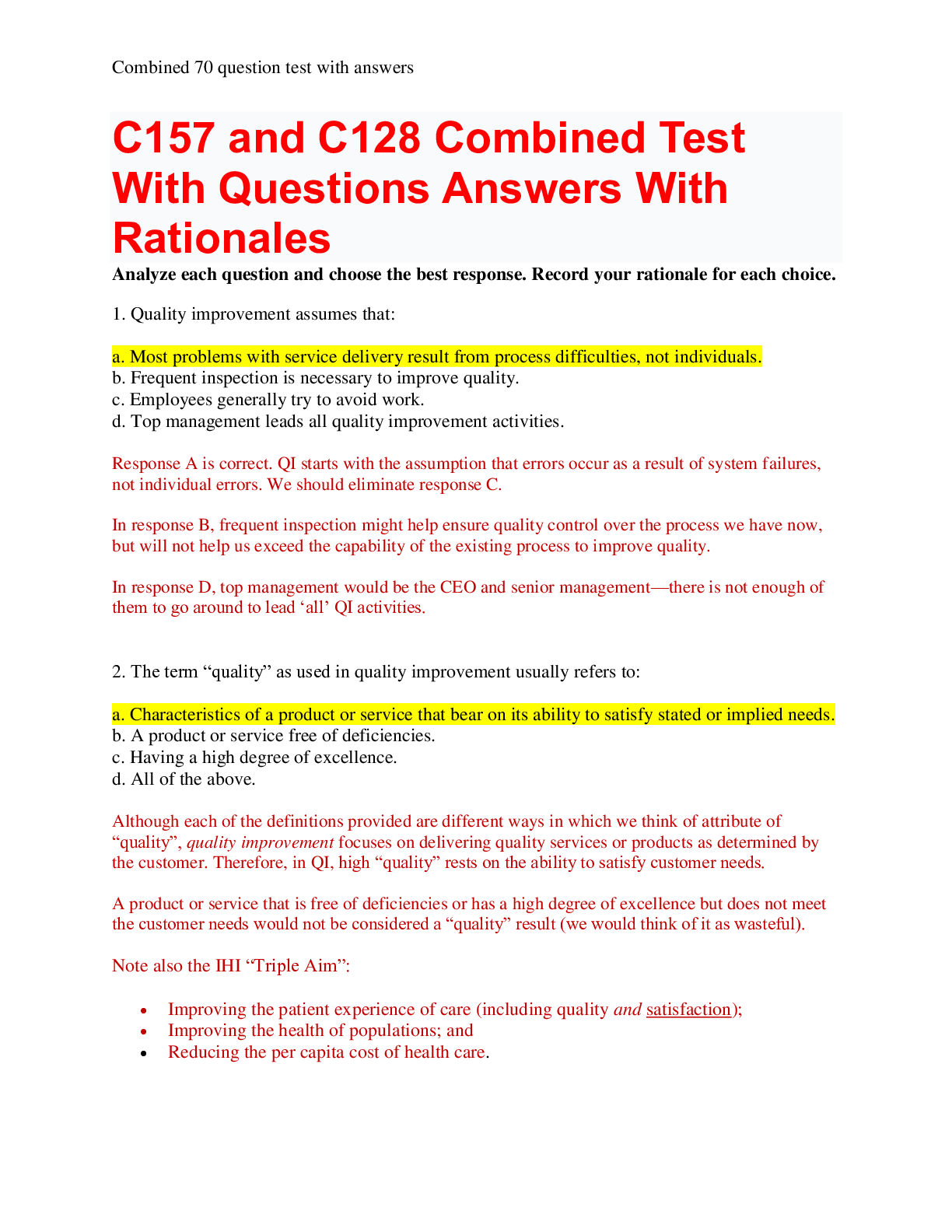
Reviews( 0 )
Recommended For You
*NURSING> STUDY GUIDE > NCLEX-PN TEST PREP QUESTIONS AND ANSWERS WITH EXPLANATIONS Study Guide to Pass the License Exam Effortlessly Exam Review for Practical Nurses (All)

NCLEX-PN TEST PREP QUESTIONS AND ANSWERS WITH EXPLANATIONS Study Guide to Pass the License Exam Effortlessly Exam Review for Practical Nurses
2020 NCLEX-PN TEST PREP QUESTIONS AND ANSWERS WITH EXPLANATIONS Study Guide to Pass the License Exam Effortlessly Exam Review for Practical Nurses.
By Kirsch , Uploaded: Jul 05, 2020
$15
*NURSING> STUDY GUIDE > 2020 NCLEX-RN TEST PREP QUESTIONS AND ANSWERS WITH EXPLANATIONS: Best Study Guide to Pass the License Exam Effortlessly (All)
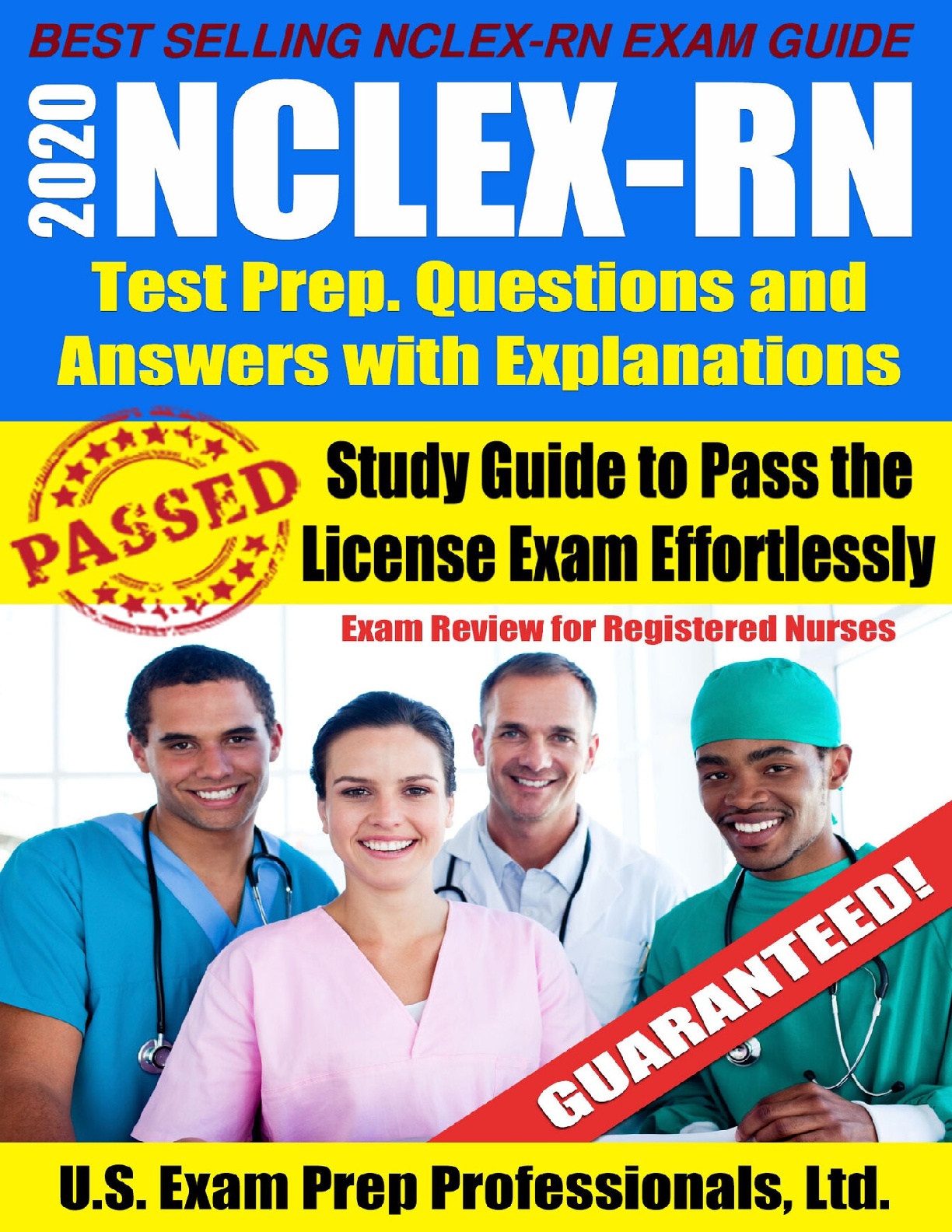
2020 NCLEX-RN TEST PREP QUESTIONS AND ANSWERS WITH EXPLANATIONS: Best Study Guide to Pass the License Exam Effortlessly
2020 NCLEX-RN TEST PREP QUESTIONS AND ANSWERS WITH EXPLANATIONS: Best Study Guide to Pass the License Exam Effortlessly TABLE OF CONTENTS INTRODUCTION 7 SECRETS TO STUDYING – HOW TO PASS ANY EXAM...
By Kirsch , Uploaded: Jun 11, 2020
$15.5
*NURSING> STUDY GUIDE > Community ATI Practice Questions and Answers with Rationales/Graded A (All)
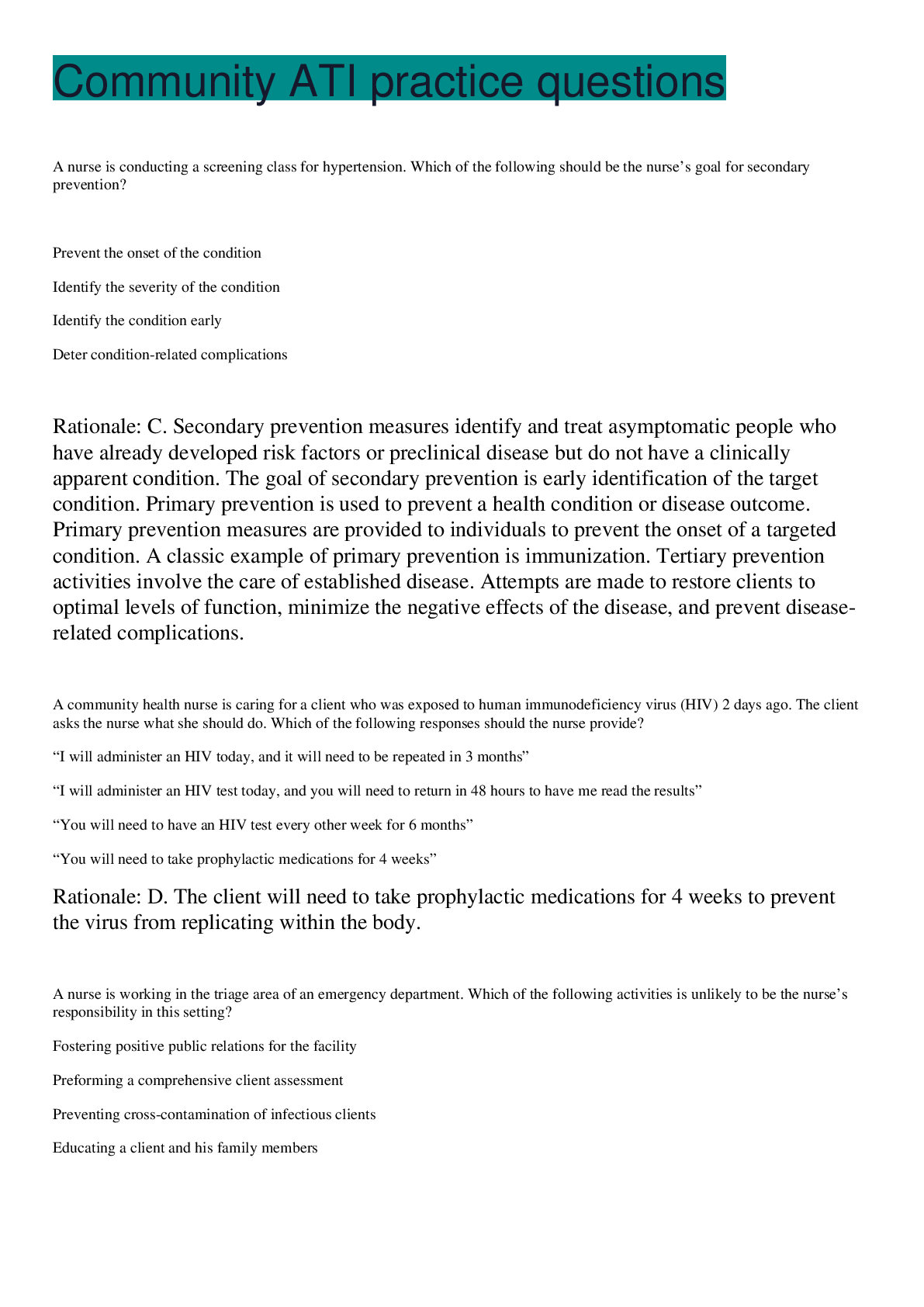
Community ATI Practice Questions and Answers with Rationales/Graded A
Community ATI Practice Questions and Answers with Rationales Community ATI Practice Questions 1. A nurse is conducting a screening class for hypertension. Which of the following should be the nurse’s...
By Succeed , Uploaded: Jun 07, 2020
$20
Health Care> STUDY GUIDE > NURS 501 Advanced Physiology and Pathophysiology STUDY GUIDE SELECTED CHAPTERS QUESTIONS AND ANSWERS WITH COMPLETE SOLUTIONS. (All)

NURS 501 Advanced Physiology and Pathophysiology STUDY GUIDE SELECTED CHAPTERS QUESTIONS AND ANSWERS WITH COMPLETE SOLUTIONS.
NURS 501 Advanced Physiology and Pathophysiology 2021/2022 EXAM GUIDE Chapter 1: Cellular Biology Study Guide Chapter 2: Altered Cellular & Tissue Study Guide Chapter 3: Fluids, Electrolytes, and...
By STUDY-GUIDENOTES , Uploaded: Oct 14, 2021
$14
*NURSING> STUDY GUIDE > NSG 3370 STUDY GUIDE – QUESTION AND ANSWERS WITH EXPLANATIONS (All)
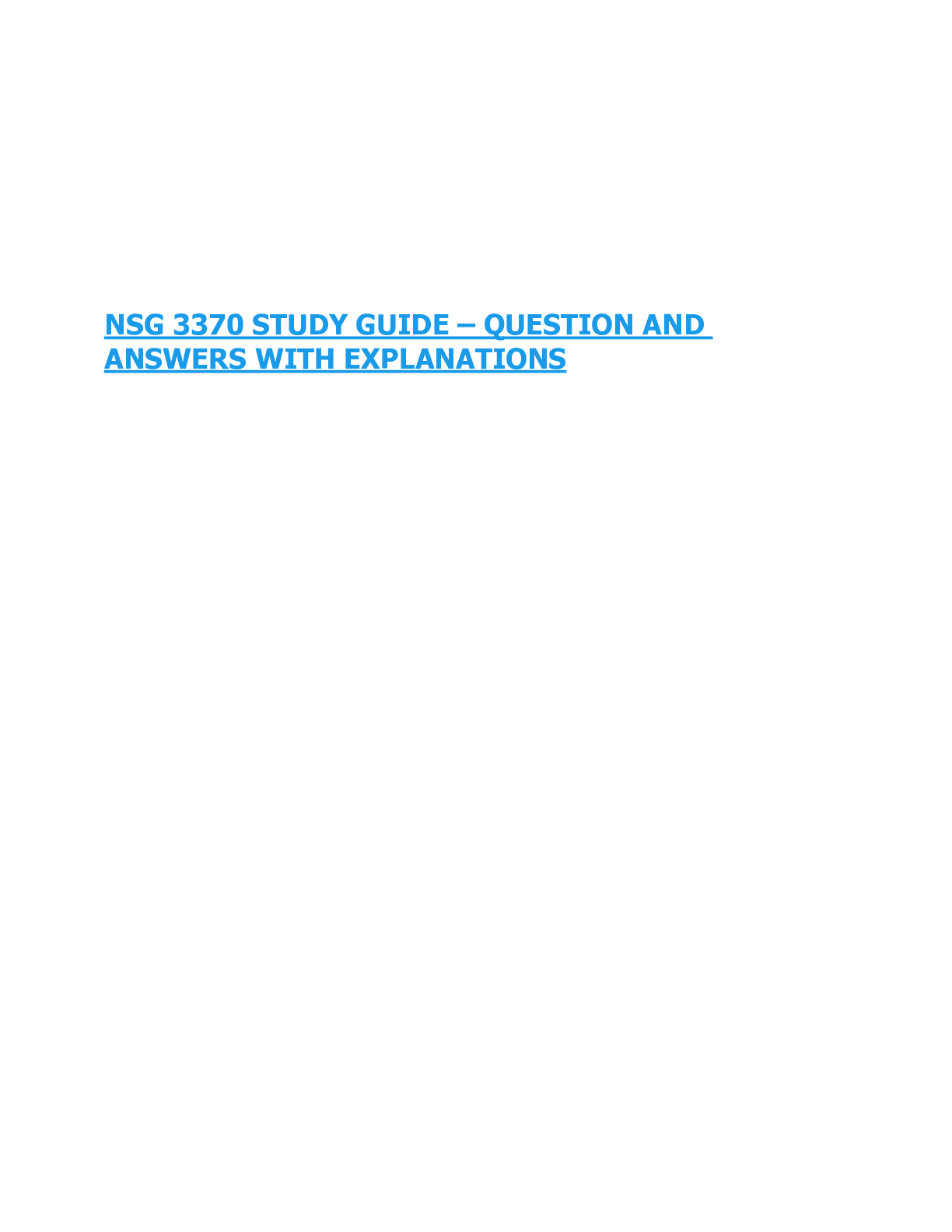
NSG 3370 STUDY GUIDE – QUESTION AND ANSWERS WITH EXPLANATIONS
During pregnancy, dyspnea accompanied by increased respiratory rate, cough, rales, or respiratory distress raises concerns of: peripartum cardiomyopathy Explanation: Dyspnea accompanied by increase...
By MAYEXPERT , Uploaded: May 23, 2022
$12.5
Biology> STUDY GUIDE > ATI Practice Exam A questions and answers with rationale (All)
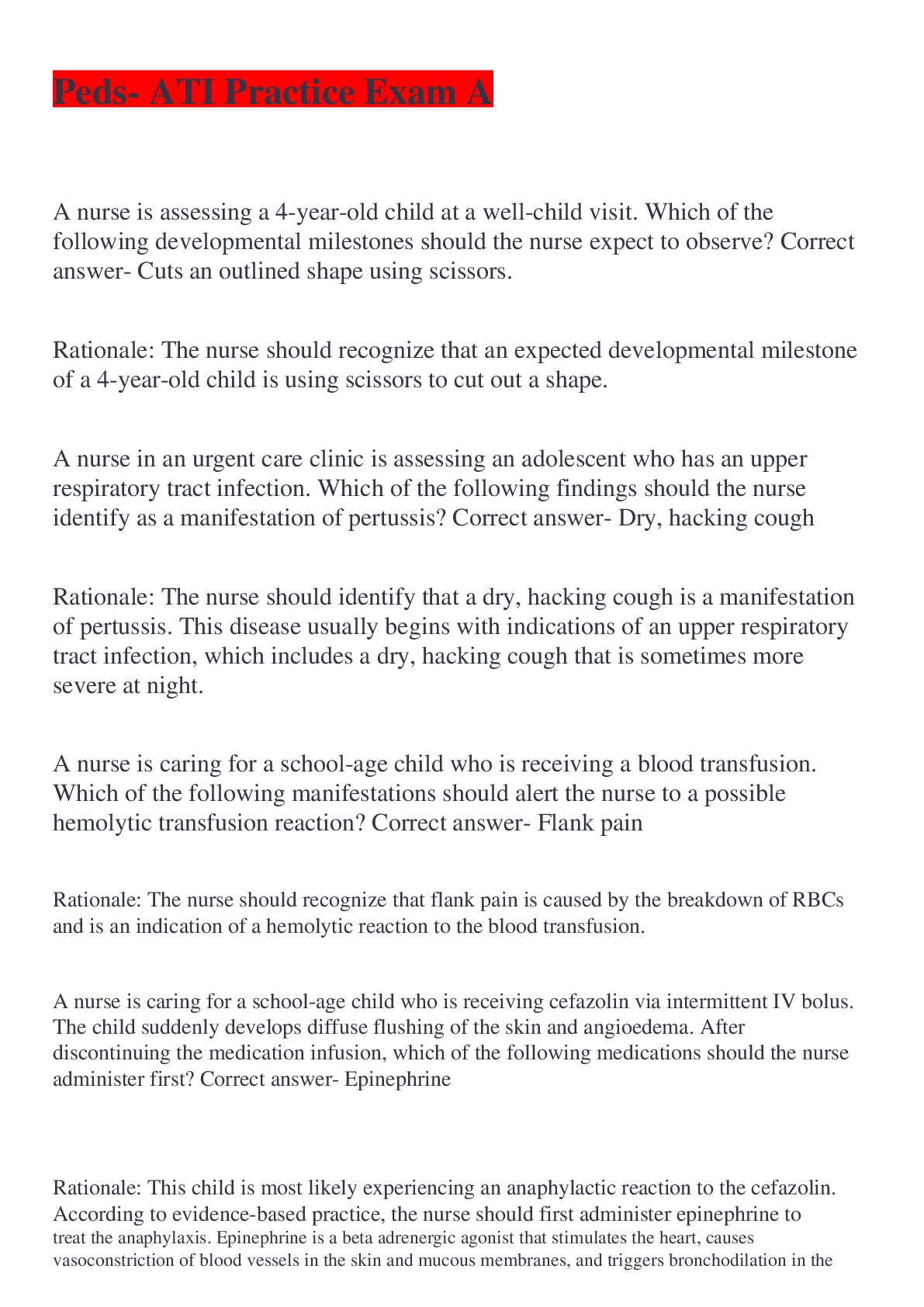
ATI Practice Exam A questions and answers with rationale
A nurse is assessing a 4-year-old child at a well-child visit. Which of the following developmental milestones should the nurse expect to observe? Correct answer- Cuts an outlined shape using scissors...
By THE LORD IS GOD , Uploaded: May 11, 2022
$13
Pharmacology> STUDY GUIDE > SAUNDERS ATI PHARMACOLOGY STUDY GUIDE. QUESTIONS AND ANSWERS WITH RATIONALE (Latest Update 2020) (All)
 (1).png)
SAUNDERS ATI PHARMACOLOGY STUDY GUIDE. QUESTIONS AND ANSWERS WITH RATIONALE (Latest Update 2020)
SAUNDERS ATI PHARMACOLOGY STUDY GUIDE. QUESTIONS AND ANSWERS WITH RATIONALE (Latest Update 2020)
By Perfectstudy , Uploaded: Feb 16, 2022
$17
Health Care> STUDY GUIDE > 2021/2022NCLEX RN TEST PREPQUESTIONS AND ANSWERS WITH EXPLANATIONS (All)
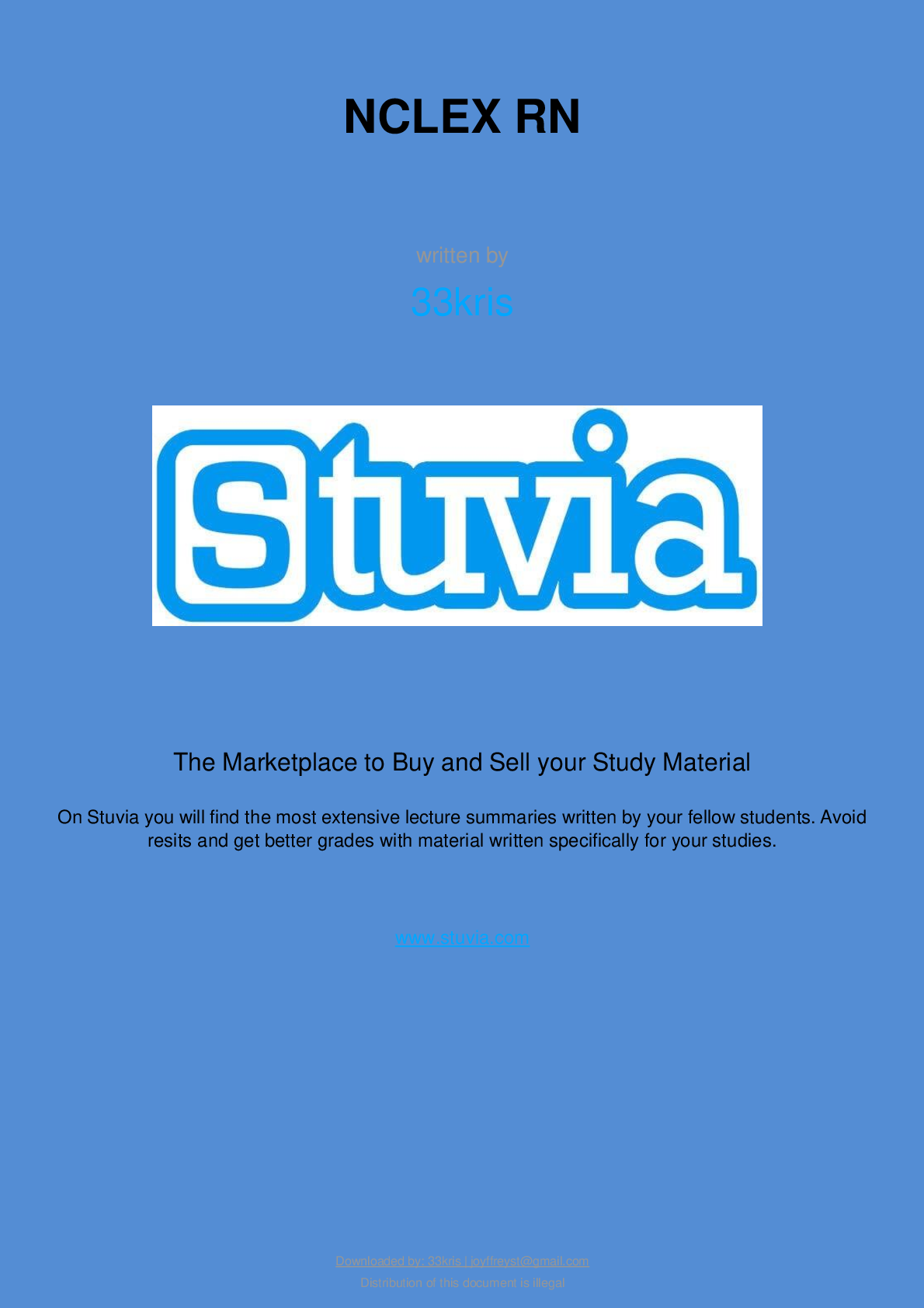
2021/2022NCLEX RN TEST PREPQUESTIONS AND ANSWERS WITH EXPLANATIONS
2021/2022 NCLEX RN TEST PREPQUESTIONS AND ANSWERS WITH EXPLANATIONSIT COVERS: 1. BASIC NURSING CARE-171 2. MANAGEMENT AND PRACTICE DIRECTIVES115 3. PREVENTING RISKS AND COMPLICATIONS-81 4. CARING...
By THE LORD IS GOD , Uploaded: Jan 26, 2022
$20
*NURSING> STUDY GUIDE > NR 601 (Comprehensive Final Exam Study Guide and Practice Questions) Final Review Questions and Answers with Explanations (STUDY MODE) Questions and Answers (latest Update), 100% Correct, Download to Score A (All)

NR 601 (Comprehensive Final Exam Study Guide and Practice Questions) Final Review Questions and Answers with Explanations (STUDY MODE) Questions and Answers (latest Update), 100% Correct, Download to Score A
NR 601 Comprehensive Final exam study guide and practice questions DISCLAIMER- None of this is my original work. The first 11 pages are the completed study guide from a previous class. Pages 11 thro...
By Nutmegs , Uploaded: Dec 28, 2021
$15
Health Care> STUDY GUIDE > ATI Adult Health II Final Exam Study Guide, Study Guide Revisions, Updated Study Guide, Correctly Answered Questions, Test bank Questions and Answers with Explanations (latest Update), 100% Correct, Download to Score A (All)
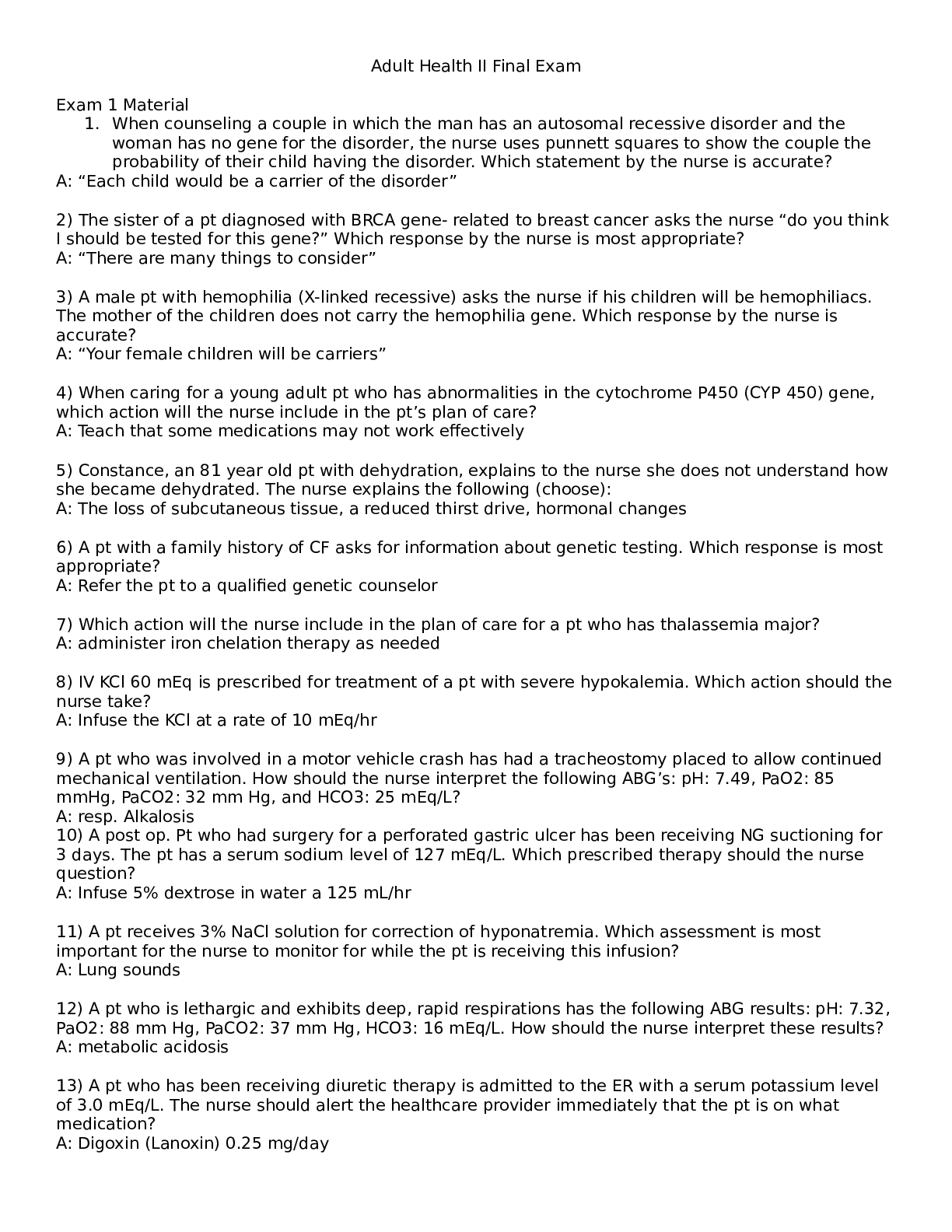
ATI Adult Health II Final Exam Study Guide, Study Guide Revisions, Updated Study Guide, Correctly Answered Questions, Test bank Questions and Answers with Explanations (latest Update), 100% Correct, Download to Score A
Adult Health II Final Exam Exam 1 Material 1. When counseling a couple in which the man has an autosomal recessive disorder and the woman has no gene for the disorder, the nurse uses punnett square...
By Nutmegs , Uploaded: Dec 20, 2021
$11
Document information
Connected school, study & course
About the document
Uploaded On
Sep 05, 2020
Number of pages
30
Written in
Additional information
This document has been written for:
Uploaded
Sep 05, 2020
Downloads
0
Views
40






